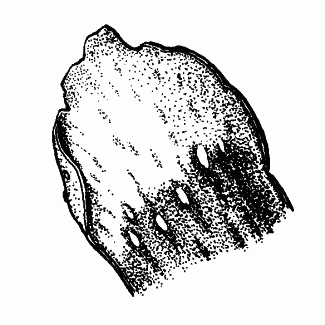Peltigera aphthosa (L.) Willd.
Silver-edge pelt
Peltigeraceae
Introduction to the Lichens
Silver-edge pelt
Peltigeraceae
Introduction to the Lichens
Map
Distribution of Peltigera aphthosa unavailable
Species Information
General:
Common Name: The Pelt Lichens. Echoes the genus name and describes the general resemblance of the species to various animal skins.
Small to large stratified foliose lichens, corticate above, noncorticate below, isidiate, sorediate or lobulate or not, cephalodiate or not, lobes loosely attached, short to subrotund, averaging to 1–3 (–4) cm wide, thin or thick. Upper surface greenish, greyish or brownish, smooth or somewhat roughened, naked or tomentose. Lower surface pale or dark, usually veined, bearing numerous rhizines, these short or long, slender or tufted. Medulla white. Photobiont green and/or blue-green.
Apothecia appressed on upper surface near margins, often saddle-shaped, disc brownish; spores 4-celled to multi-celled, ellipsoid or needlelike/acicular, colourless or brown at maturity, (2–) 8 per ascus.
Over soil and moss, occasionally over trees.
Notes: All but one of the 30 Peltigera species reported for North America are known to occur in B.C. Peltigera is a taxonomically rather difficult genus containing a number of species groups that are not yet satisfactorily elucidated. Chemistry is highly variable in this group; though thin-layer chromatography may help to identify some species, spot test reactions do not.
Species description:
Photobiont a lime-green to grass-green alga; upper surface generally greenish, especially when wet (Note: check sheltered lobes); wart-like cephalodia sometimes present over upper or lower surface AND
Cephalodia present over upper surface AND
Lower surface darkening abruptly inward of lobe tips; undersides of apothecia green-corticate throughout; veins generally either indistinct or absent AND
Mature cephalodia closely appressed throughout not at all peltate, never detaching or enlarging; widespread
Comments:
Like other members of the P. aphthosa group (i.e., including P. britannica and P. leucophlebia), P. aphthosamay occasionally give rise, through its cephalodia, to discrete blue-green thalli. Such thalli, first reported from Norway by Tønsberg and Holtan-Hartwig (1983), represent P. aphthosa’s blue-green phototype. Recently this phototype was detected in inland B.C. (Goward et al. 1994b) where, together with that of P. leucophlebia, it appears to be very rare. The blue-green phototype of P. britannica has also been reported from B.C. (Brodo and Richardson 1978), but seems not uncommon in humid lowland localities in the southern half of the province. All three phototypes have a bluish grey upper surface that is flecked with thin, white, angular markings/maculae. These taxa are most reliably distinguished from one another on the basis of the associated green thalli (i.e., whether P. aphthosa, P. britannica or P. leucophlebia). See also notes under Peltigera sp. 1.
Contents:
Both phototypes: gyrophoric acid, methyl gyrophorate, tenuiorin, (phlebic acid A and B), and various unknowns.
Source: Lichens of British Columbia
Illustration

If more than one illustration is available for a species (e.g., separate illustrations were provided for two subspecies) then links to the separate images will be provided below. Note that individual subspecies or varietal illustrations are not always available.
Illustration By: Trevor Goward
Habitat and Range
Habitat: Common over soil, moss, duff, logs and rock in open to somewhat shady inland localities, also rare in maritime localitiesWorld Distribution: circumpolar, S to CA and NM.
Source: Lichens of British Columbia